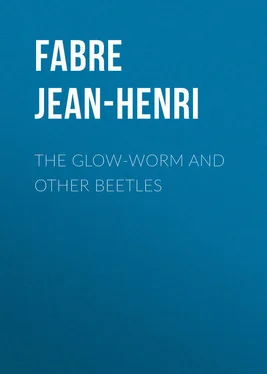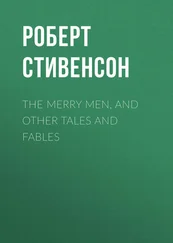Jean-Henri Fabre - The Glow-Worm and Other Beetles
Здесь есть возможность читать онлайн «Jean-Henri Fabre - The Glow-Worm and Other Beetles» — ознакомительный отрывок электронной книги совершенно бесплатно, а после прочтения отрывка купить полную версию. В некоторых случаях можно слушать аудио, скачать через торрент в формате fb2 и присутствует краткое содержание. Жанр: foreign_antique, foreign_prose, на английском языке. Описание произведения, (предисловие) а так же отзывы посетителей доступны на портале библиотеки ЛибКат.
- Название:The Glow-Worm and Other Beetles
- Автор:
- Жанр:
- Год:неизвестен
- ISBN:нет данных
- Рейтинг книги:5 / 5. Голосов: 1
-
Избранное:Добавить в избранное
- Отзывы:
-
Ваша оценка:
- 100
- 1
- 2
- 3
- 4
- 5
The Glow-Worm and Other Beetles: краткое содержание, описание и аннотация
Предлагаем к чтению аннотацию, описание, краткое содержание или предисловие (зависит от того, что написал сам автор книги «The Glow-Worm and Other Beetles»). Если вы не нашли необходимую информацию о книге — напишите в комментариях, мы постараемся отыскать её.
The Glow-Worm and Other Beetles — читать онлайн ознакомительный отрывок
Ниже представлен текст книги, разбитый по страницам. Система сохранения места последней прочитанной страницы, позволяет с удобством читать онлайн бесплатно книгу «The Glow-Worm and Other Beetles», без необходимости каждый раз заново искать на чём Вы остановились. Поставьте закладку, и сможете в любой момент перейти на страницу, на которой закончили чтение.
Интервал:
Закладка:
In support of these deductions, here is a fairly conclusive experiment, though it reproduces the natural circumstances but roughly. On a female taken in her cell and therefore free from Sitares, I place a male who is infested with them; and I keep the two sexes in contact, suppressing their unruly movements as far as I am able. After fifteen or twenty minutes of this enforced proximity, the female is invaded by one or more of the larvæ which at first were on the male. True, experiment does not always succeed under these imperfect conditions.
By watching at Avignon the few Anthophoræ that I succeeded in discovering, I was able to detect the precise moment of their work; and on the following Thursday, 16 16 Thursday is the weekly holiday in French schools. — Translator's Note .
the 21st of May, I repaired in all haste to Carpentras, to witness, if possible, the entrance of the Sitares into the Bee's cells. I was not mistaken: the works were in full swing.
In front of a high expanse of earth, a swarm stimulated by the sun, which floods it with light and heat, is dancing a crazy ballet. It is a hover of Anthophoræ, a few feet thick and covering an area which matches the sort of house-front formed by the perpendicular soil. From the tumultuous heart of the cloud rises a monotonous, threatening murmur, while the bewildered eye strays through the inextricable evolutions of the eager throng. With the rapidity of a lightning-flash thousands of Anthophoræ are incessantly flying off and scattering over the country-side in search of booty; thousands of others also are incessantly arriving, laden with honey or mortar, and keeping up the formidable proportions of the swarm.
I was at that time something of a novice as regards the nature of these insects:
"Woe," said I to myself, "woe to the reckless wight bold enough to enter the heart of this swarm and, above all, to lay a rash hand upon the dwellings under construction! Forthwith surrounded by the furious host, he would expiate his rash attempt, stabbed by a thousand stings!"
At this thought, rendered still more alarming by the recollection of certain misadventures of which I had been the victim when seeking to observe too closely the combs of the Hornet ( Vespa crabro ), I felt a shiver of apprehension pass through my body.
Yet, to obtain light upon the question which brings me hither, I must needs penetrate the fearsome swarm; I must stand for whole hours, perhaps all day, watching the works which I intend to upset; lens in hand, I must scrutinize, unmoved amid the whirl, the things that are happening in the cells. The use moreover of a mask, of gloves, of a covering of any kind is impracticable, for utter dexterity of the fingers and complete liberty of sight are essential to the investigations which I have to make. No matter: even though I leave this wasps'-nest with a face swollen beyond recognition, I must to-day obtain a decisive solution of the problem which has preoccupied me too long.
A few strokes of the net, aimed, beyond the limits of the swarm, at the Anthophoræ on their way to the harvest or returning, soon informed me that the Sitaris-larvæ are perched on the thorax, as I expected, occupying the same position as on the males. The circumstances therefore could not be more favourable. We will inspect the cells without further delay.
My preparations are made at once: I button my clothes tightly, so as to afford the Bees the least possible opportunity, and I enter the heart of the swarm. A few blows of the mattock, which arouse a far from reassuring crescendo in the humming of the Anthophoræ, soon place me in possession of a lump of earth; and I beat a hasty retreat, greatly astonished to find myself still safe and sound and unpursued. But the lump of earth which I have removed is from a part too near the surface; it contains nothing but Osmia-cells, which do not interest me for the moment. A second expedition is made, lasting longer than the first; and, though my retreat is effected without great precipitation, not an Anthophora has touched me with her sting, nor even shown herself disposed to fall upon the aggressor.
This success emboldens me. I remain permanently in front of the work in progress, continually removing lumps of earth filled with cells, spilling the liquid honey on the ground, eviscerating larvæ and crushing the Bees busily occupied in their nests. All this devastation results merely in arousing a louder hum in the swarm and is not followed by any hostile demonstration. The Anthophoræ whose cells are not hurt go about their labours as if nothing unusual were happening round about them; those whose dwellings are overturned try to repair them, or hover distractedly in front of the ruins; but none of them seems inclined to swoop down upon the author of the damage. At most, a few, more irritated than the rest, come at intervals and hover before my face, confronting me at a distance of a couple of inches, and then fly away, after a few moments of this curious inspection.
Despite the selection of a common site for their nests, which might suggest an attempt at communistic interests among the Anthophoræ, these Bees, therefore, obey the egotistical law of each one for himself and do not know how to band themselves together to repel an enemy who threatens one and all. Taken singly, the Anthophora does not even know how to dash at the enemy who is ravaging her cells and drive him away with her stings; the pacific creature hastily leaves its dwelling when disturbed by undermining and escapes in a crippled state, sometimes even mortally wounded, without thinking of making use of its venomous sting, except when it is seized and handled. Many other Hymenoptera, honey-gatherers or hunters, are quite as spiritless; and I can assert to-day, after a long experience, that only the Social Hymenoptera, the Hive-bees, the Common Wasps and the Bumble-bees, know how to devise a common defence; and only they dare fall singly upon the aggressor, to wreak an individual vengeance.
Thanks to this unexpected lack of spirit in the Mason-bee, I was able for hours to pursue my investigations at my leisure, seated on a stone in the midst of the murmuring and distracted swarm, without receiving a single sting, though I took no precautions whatever. Country-folk, happening to pass and beholding me seated, unperturbed, in the midst of the whirl of Bees, stopped aghast to ask me whether I had bewitched them, whether I charmed them, since I appeared to have nothing to fear from them:
"Mé, moun bel ami, li-z-avé doun escounjurado què vous pougnioun pas, canèu de sort!"
My miscellaneous impedimenta spread over the ground, boxes, glass jars and tubes, tweezers and magnifying-glasses, were certainly regarded by these good people as the implements of my wizardry.
We will now proceed to examine the cells. Some are still open and contain only a more or less complete store of honey. Others are hermetically sealed with an earthen lid. The contents of these latter vary greatly. Sometimes we find the larva of a Bee which has finished its mess or is on the point of finishing it; sometimes a larva, white like the first, but more corpulent and of a different shape; at other times honey with an egg floating on the surface. The honey is liquid and sticky, with a brownish colour and a very strong, repulsive smell. The egg is of a beautiful white, cylindrical in shape, slightly curved into an arc, a fifth or a sixth of an inch in length and not quite a twenty-fifth of an inch in thickness; it is the egg of the Anthophora.
In a few cells this egg is floating all alone on the surface of the honey; in others, very numerous these, we see, lying on the egg of the Anthophora, as on a sort of raft, a young Sitaris-grub with the shape and the dimensions which I have described above, that is to say, with the shape and the dimensions which the creature possesses on leaving the egg. This is the enemy within the gates.
Читать дальшеИнтервал:
Закладка:
Похожие книги на «The Glow-Worm and Other Beetles»
Представляем Вашему вниманию похожие книги на «The Glow-Worm and Other Beetles» списком для выбора. Мы отобрали схожую по названию и смыслу литературу в надежде предоставить читателям больше вариантов отыскать новые, интересные, ещё непрочитанные произведения.
Обсуждение, отзывы о книге «The Glow-Worm and Other Beetles» и просто собственные мнения читателей. Оставьте ваши комментарии, напишите, что Вы думаете о произведении, его смысле или главных героях. Укажите что конкретно понравилось, а что нет, и почему Вы так считаете.












